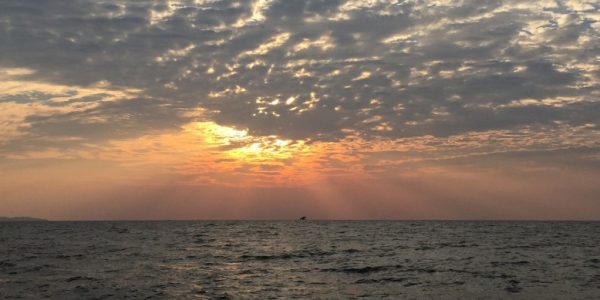We wake to rain! The first we have seen four weeks. Moshi means smoke in Kiswahili and The mist covered mountain is as if shrouded in smoke. Looks like we’ll be unable to see it on this visit.
Today we are going on a coffee tour. This will take us over 2000m up onto Kilamanjaro to the uppermost coffee growing region.
 We are greeted by our guide “Everest”, over a cup of what else but coffee. This 74 year old Mzee is our guide for the day.
We are greeted by our guide “Everest”, over a cup of what else but coffee. This 74 year old Mzee is our guide for the day.
He takes us to a small-holding where we are greeted by the owner. We are taken through the process of making coffee from the plant.
Coffee was introduced here in 1922, from Ethiopia. Coffee plants grow from dried coffee beans which need to be placed groove down in the south l to ensure quick germination.
 This will germinate within a few weeks whereupon it is transplanted into a bigger plot. The plant will take two years to mature and within 5 years it will be producing about 5kg of coffee each year.
This will germinate within a few weeks whereupon it is transplanted into a bigger plot. The plant will take two years to mature and within 5 years it will be producing about 5kg of coffee each year.
Coffee plants are grown beneath banana plants for shade and are sprayed with organic pesticides derived from a local plant, to keep of insects which prevent the growth of the bean.

The coffee cherries are harvested between July and December when the fruits are red.


The beans are extracted and the fruits discarded, using a mechanical process. The device is so expensive that it must be shared between farmers.


The beans are then fermented for a day or so then dried before moving on to the next stage.
A device similar to a pestle and mortar (called a locomotor) is used to de husk the beans leaving green beans.
 The mix is sifted to remove the husks.
The mix is sifted to remove the husks.

The green beans are then toasted in an aluminum pot until they are turned to a dark brown colour.



Here in this village the Arabica beans are then ground in the locomotor to a course powder and sifted and reground to a finer powder.




We then enjoy a cup of well earned hand-made coffee.

Having gone through the process we were taken on a village tours. Everest pointed out the various plants including several types of banana.










A taxi ride to town and we do some coffee shopping before adding another mode of transport to our list. These are called Bajaj and are a three wheel tuctucs


We return to Tembo Tamu our B&B. This place has a shady garden.
Modes of Transport
- On foot
- Taxi(2)
- Bijaj
Distance(miles)
- 30
Accommodation
- Three bed cottage – Tembo Tamu
Cost (including breakfast)
- $75
Location
- Moshi











Wonderful!! Love the ☕️ experience!! 😊👍
LikeLiked by 1 person